#MEAN Stack Vs MERN Stack
Explore tagged Tumblr posts
Text
#MEAN Stack vs MERN Stack#MEAN Stack development Company#MERN Stack development company#MEAN Stack development Services#MERN Stack Development Services#hire mean stack developers#Hire MERN Stack Developers
0 notes
Text
MEAN Vs. MERN: Which Is Best For Web Development | SynergyTop
Unravel the MEAN vs. MERN debate for Web Development with SynergyTop! As the global web development market soars to USD 96,748.41 million by 2028, make your choice count. Delve into our insightful blog at SynergyTop to navigate through the complexities of tech stacks. Whether it's MEAN or MERN, trust SynergyTop's expertise for personalized guidance. Schedule your consultation today!
#mean stack vs mern stack#mern stack vs mean stack#mern vs mean#mern vs mean stack#mean vs mern stack#mean vs mern#mean and mern stack#MERN stack#MEAN stack
0 notes
Text
youtube
Which Tech Stack To Choose In 2023? MEAN Stack Vs MERN Stack | MEAN Vs MERN
RichestSoft, a leader in software development, provides expertise in both MEAN (MongoDB, Express.js, AngularJS, Node.js) and MERN (MongoDB, Express.js, React.js, Node.js) stacks. With a focus on innovation and efficiency, RichestSoft tailors solutions to client needs, leveraging the strengths of each stack. Whether it's MEAN for robust web applications or MERN for dynamic user interfaces, RichestSoft ensures cutting-edge technology for unparalleled results.
0 notes
Text
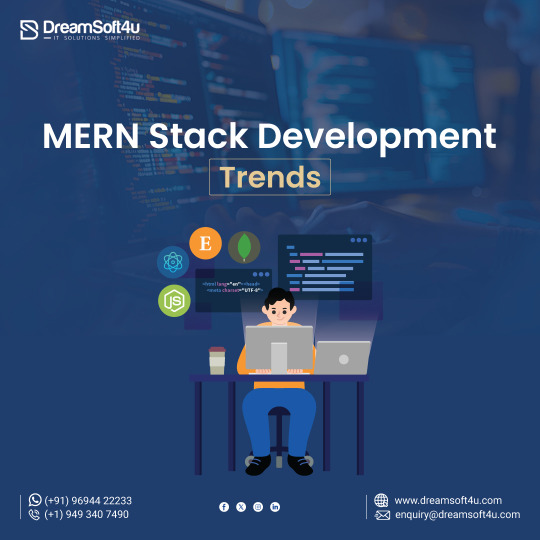
MERN stack is the prevalent web app development approach nowadays. If you have not tried MERN Stack before do not worry it is easier than it looks. MERN is the acronym that is made from the combination of MongoDB, Express.js, React, and Node.js as tools used in Full Stack Development. This stack is popular due to its ability to be open source, fast, and use JavaScript on the front and back end. So we need to follow the latest MERN Stack Development Trends.
#mean stack developer#mern stack development company#mern stack development services#mern stack vs mean stack
0 notes
Text
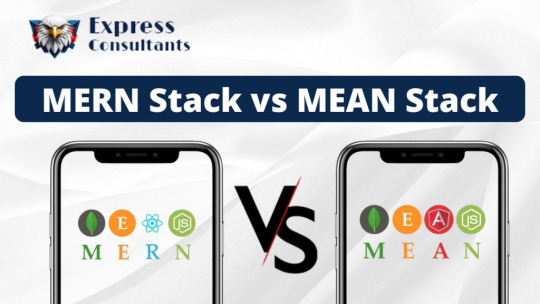
“In the world of web development, the choice of stack can make or break a project.” This statement might sound bold, but it’s spot on. The stacks you choose dictate how flexible, scalable, and efficient your application can be.
0 notes
Text
#MERN Stack Development#mern stack vs mean stack#MERN Stack Website Development#MERN Stack Developer#MERN stack API development#MERN stack development services#hire mern stack developers
0 notes
Text
Key Differences Between MEAN Stack & MERN Stack

Discover Key Differences Between MEAN Stack & MERN Stack with fundamental differences in their syntax, performance, memory management, and more.
0 notes
Text
Unlocking the Power of Full-Stack Development: Your Comprehensive Guide
Full-stack development involves the process of developing both front-end and back-end components in a web application. A full-stack developement, therefore, will have the skills for creating a full web application- from the interface to the server-side logic to database management.
Front-End Development:
The front end refers to the parts of a web application that involve users' interactions directly. Basically, it requires designing and development in the visuals of a site, such as layout, design, and user interfaces.
The main technology applied in frontend development includes:
HTML (HyperText Markup Language), which gives an outline of structure in web pages and enables designers to define, for example headings, paragraphs links, and pictures.
CSS: Controls presentation and layout of web pages; this enables developers to add color, font, and spacing to a website.
JavaScript: This language makes the web page interactive; this includes updating dynamic content, form validations, and even making things interactive.
In addition to that, popular front-end development frameworks and libraries are used in many projects for React, Angular, and Vue.js.
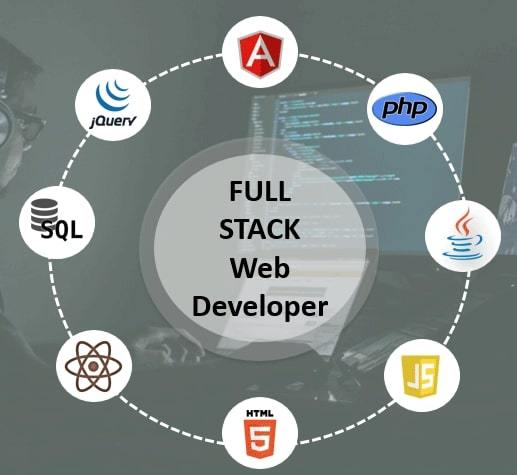
Back-End Development:
The back end, or the server side, controls the managing of the server, application, and database which power the front end. They include business logic, database interaction, authentication, and server configurations.
Some key technologies used in back-end development are:
Server-Side Languages: This entails the use of languages such as Node.js, Python, Ruby, Java, and PHP to develop the server side.
Databases: These entail the use of systems such as MongoDB, MySQL, PostgreSQL, and Oracle, to store data and manage information.
Server Management: These tools and platforms include Apache, Nginx, and even cloud services (AWS, Azure) for resource management and server deployment.
Full-stack developers work to ensure there is no disparity between the front end and the back end while creating a completely functional web application.
Popular Full-Stack Development Stacks:
A "stack" is an accumulation of various technologies used in combination to deliver a fully fledged web application.
Some popular full-stack development stacks include:
MEAN Stack: This stack consists of MongoDB as a database, Express.js as a back-end framework, Angular as the front-end framework, and Node.js as a runtime environment.
MERN Stack: Similar to the MEAN, but this one uses React as the front end.
LAMP Stack: Consists of Linux, Apache, MySQL, and PHP as the server-side language.
These stacks offer a standardized set of tools that simplify the development process and ensure compatibility between different components.
Advantages of Full-Stack Development:
Engaging in full-stack development offers several benefits:
Versatility: Full-stack developers can handle both the front end and the back end. This makes them flexible to handle different requirements for projects.
Efficiency: In full-stack development, one developer or a team of developers can manage everything. This reduces communication barriers and saves development time.
Problem-Solving: A full-stack developer has a clear understanding of the entire application. This makes them better at finding and solving problems.
There is a significant demand for full-stack developers as it is anticipated that their job prospects will rise to 16% by 2031 due to the requirement of web development developers who are proficient in every single area.
Challenges in Full-Stack Development:
Full-stack development has several benefits, but there are also challenges involved:
Constant Learning: Since web technologies change very fast, full-stack developers have to keep themselves updated constantly.
Depth vs. Breadth: While a full-stack developer can do a little bit of everything, the depth of knowledge in each area might not be as strong as it is for a specialist.
Managing Workload: Front-end and back-end development at the same time is a big responsibility, which demands good time management and prioritization skills.
Becoming a Full-Stack Developer:
A person who wishes to pursue full-stack development as a career should:
Education: Have a proper grounding in computer science principles and web development either from formal education or coding bootcamps.
Skill Development: Front-end and back-end technologies should be learned including HTML, CSS, JavaScript, server-side languages, and database management.
Practical Experience: Projects must include both front-end and back-end development in order to be applied and perfected.
Continual learning in current trends and web development technology in order to keep up in this field of practice.
Being proficient in front-end and back-end development, the full-stack developers are an integral part in designing dynamic, interactive web applications. They form the bridge that ties together user experience with server-side functionality.
0 notes
Text
MERN/MEAN Full Stack Developer Course with AI & IoT Integrated
Join TechEntry's MERN/MEAN Full Stack Development Course. Learn to build advanced web applications with AI and IoT integration. Master Node.js, Angular, React, and MongoDB. Enroll now to kickstart your successful career!
Why Settle for Just Full Stack Development? Become an AI Full Stack Engineer!
The tech industry is evolving fast, and companies are no longer just looking for MERN/MEAN stack developers. They want professionals who can integrate cutting edge technologies like AI and IoT into their development processes. This is where TechEntry stands out.
Kickstart Your Development Journey!
Frontend Development:
React: Build Dynamic, Modern Web Experiences:
What is Web?
Markup with HTML & JSX
Flexbox, Grid & Responsiveness
Bootstrap Layouts & Components
Frontend UI Framework
Core JavaScript & Object Orientation
Async JS promises, async/await
DOM & Events
Event Bubbling & Delegation
Ajax, Axios & fetch API
Functional React Components
Props & State Management
Dynamic Component Styling
Functions as Props
Hooks in React : useState, useEffect
Material UI
Custom Hooks
Supplement: Redux & Redux Toolkit
Version Control: Git & Github
Angular: Master a FullFeatured Framework:
What is Web?
Markup with HTML & Angular Templates
Flexbox, Grid & Responsiveness
Angular Material Layouts & Components
Core JavaScript & TypeScript
Asynchronous Programming Promises, Observables, and RxJS
DOM Manipulation & Events
Event Binding & Event Bubbling
HTTP Client, Ajax, Axios & Fetch API
Angular Components
Input & Output Property Binding
Dynamic Component Styling
Services & Dependency Injection
Angular Directives (Structural & Attribute)
Routing & Navigation
Reactive Forms & Templatedriven Forms
State Management with NgRx
Custom Pipes & Directives
Version Control: Git & GitHub
Backend:
Node.js: Power Your BackEnd with JavaScript:
Networking and HTTP
REST API overview
Node.js and NPM setup
Creating basic HTTP servers
JavaScript for Backend
Node.js modules and file handling
Process management in Node.js
Asynchronous programming: callbacks, Promises, async/await
Building APIs with Express.js
Express server setup and routing
Handling HTTP requests and responses
JSON parsing and form handling
Templating engines (EJS, Handlebars)
CRUD API creation and RESTful services
Middleware setup and error handling
Database Integration:
SQL and NoSQL database basics
CRUD operations with SQL and NoSQL
Database connection setup (e.g., MongoDB, PostgreSQL)
Querying and data handling
Authentication & Authorization:
User authentication basics
JSON Web Tokens (JWT) for security
Rolebased access control
Advanced API Concepts:
Pagination, filtering, and sorting
Caching techniques for faster response
Rate limiting and security practices
Database:
MongoDB (NoSQL)
Introduction to NoSQL and MongoDB
Understanding Collections and Documents
Basic CRUD Operations in MongoDB
MongoDB Query Language (MQL) Basics
Inserting, Finding, Updating, and Deleting Documents
Using Filters and Projections in Queries
Understanding Data Types in MongoDB
Indexing Basics in MongoDB
Setting Up a Simple MongoDB Database (e.g., MongoDB Atlas)
Connecting to MongoDB from a Simple Application
Basic Data Entry and Querying with MongoDB Compass
Data Modeling in MongoDB: Embedding vs. Referencing
Overview of Aggregation Framework in MongoDB
SQL
Introduction to SQL (Structured Query Language)
Basic CRUD Operations: Create, Read, Update, Delete
Understanding Tables, Rows, and Columns
Primary Keys and Unique Constraints
Simple SQL Queries: SELECT, WHERE, and ORDER BY
Filtering Data with Conditions
Using Aggregate Functions: COUNT, SUM, AVG
Grouping Data with GROUP BY
Basic Joins: Combining Tables (INNER JOIN)
Data Types in SQL (e.g., INT, VARCHAR, DATE)
Setting Up a Simple SQL Database (e.g., SQLite or MySQL)
Connecting to a SQL Database from a Simple Application
Basic Data Entry and Querying with a GUI Tool
Data Validation Basics
Overview of Transactions and ACID Properties
AI and IoT:
Introduction to AI Concepts
Getting Started with Node.js for AI
Machine Learning Basics with TensorFlow.js
Introduction to Natural Language Processing
Practical AI Project Ideas
Introduction to IoT Fundamentals
Building IoT Solutions with Node.js
IoT Communication Protocols
Building IoT Applications and Dashboards
IoT Security Basics
You're Ready to Become an IT Professional
Master the Skills and Launch Your Career: Upon mastering Frontend, Backend, Database, AI, and IoT, you’ll be fully equipped to launch your IT career confidently.
TechEntry Highlights
InOffice Experience: Engage in a collaborative inoffice environment (onsite) for handson learning and networking.
Learn from Software Engineers: Gain insights from experienced engineers actively working in the industry today.
Career Guidance: Receive tailored advice on career paths and job opportunities in tech.
Industry Trends: Explore the latest software development trends to stay ahead in your field.
1on1 Mentorship: Access personalized mentorship for project feedback and ongoing professional development.
HandsOn Projects: Work on realworld projects to apply your skills and build your portfolio.
What You Gain:
A deep understanding of Frontend React.js and Backend Node.js.
Practical skills in AI tools and IoT integration.
The confidence to work on realtime solutions and prepare for highpaying jobs.
The skills that are in demand across the tech industry, ensuring you're not just employable but soughtafter.
Frequently Asked Questions
Q: What is Node.js, and what is it used for?
A: Node.js is a runtime environment that allows you to execute JavaScript code outside of a web browser, typically on a server. It is used for building scalable server side applications, handling I/Oheavy operations, realtime applications, APIs, and microservices.
Q: What is the difference between class based components and functional components with hooks in React?
A: Class based components maintain state via instances, while functional components use hooks for state management and other side effects. Hooks have made functional components more popular due to their simplicity and flexibility.
Q: What are the popular frameworks for building web applications with Node.js?
A: Popular frameworks include Express.js, Koa.js, and Nest.js. They provide higher level abstractions and utilities to simplify building web applications.
Q: What is Angular, and why should I learn it?
A: Angular is a powerful framework for building dynamic, single page web applications. It provides a comprehensive solution with builtin tools for routing, forms, and dependency injection, making it highly valued in the job market.
Q: Why is Express.js preferred for beginners?
A: Express.js has a minimalistic and straightforward approach, making it easier for beginners to grasp core web development concepts without being overwhelmed by too many builtin features. It also has a large community and abundant resources.
Q: What are Angular’s life cycle hooks, and how are they used?
A: Angular’s life cycle hooks are methods that allow you to tap into specific moments in a component’s life cycle (e.g., initialization, change detection, destruction). Examples include ngOnInit, ngOnChanges, and ngOnDestroy.
Q: What is React, and why is it popular?
A: React is a JavaScript library for building user interfaces, particularly for single page applications. It is popular due to its reusable components, fast performance with virtual DOM, and one way data flow, making the code predictable and easy to debug.
Q: What are the job roles available for someone skilled in Node.js, Express.js, React, and Angular?
A: Job roles include Backend Developer, Frontend Developer, Full Stack Developer, API Developer, UI/UX Developer, DevOps Engineer, and Systems Architect.
Q: What is JSX in React?
A: JSX is a syntax extension of JavaScript used to create React elements. It allows you to write HTML elements and JavaScript together, making it easier to structure components and manage the user interface.
Q: What are some realworld applications built with these technologies?
A: Realworld applications include platforms like Netflix, LinkedIn, and PayPal (Node.js and Express.js); dynamic singlepage applications (React); and enterpriselevel applications (Angular). These technologies are used to handle high traffic, realtime features, and complex user interfaces.
For more, visit our website:
https://techentry.in/courses/nodejs-fullstack-mean-mern-course
0 notes
Text
Explore the differences between Full-Stack, MEAN, and MERN Stacks. Find the best stack for your project in our comprehensive 2024 guide!

#Full Stack vs MEAN vs MERN Stack#Full stack development company#MEAN Stack development company#MERN Stack Development company#Full stack vs MEAN Stack#Full stack vs MERN Stack#Hire full stack developers#hire mean stack developers#hire mern stack developers#Best mobile app development company#Hire mobile app developers#custom web app development company#hire web developers
0 notes
Text
Why You Should Hire Dedicated MERN Stack Developers for Your Next Project .
In today’s digital world, businesses are looking for highly efficient and scalable solutions to stay competitive. One of the most popular technologies in web development is the MERN stack, which offers a robust combination of MongoDB, Express.js, React.js, and Node.js. If you're considering building a dynamic and interactive web application, hire dedicated MERN Stack developers is the perfect solution for your project.
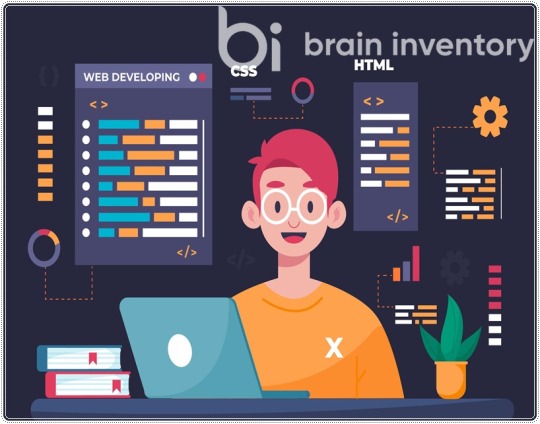
What is MERN Stack Development?
The MERN stack is a powerful JavaScript framework used to build modern web applications. It consists of:
MongoDB: A NoSQL database that stores data in a flexible, JSON-like format.
Express.js: A minimal and flexible Node.js web application framework that simplifies server-side development.
React.js: A popular JavaScript library for building interactive user interfaces.
Node.js: A runtime environment for executing JavaScript on the server side.
By hiring dedicated MERN Stack developers, you ensure that your project is handled by experts skilled in each of these technologies. The stack's uniformity — with all technologies based on JavaScript — allows for smoother development, faster coding, and a more cohesive architecture.
Why Hire Dedicated MERN Stack Developers?
Expertise and Experience: When you hire dedicated MERN stack developers, you are working with professionals who have in-depth knowledge of the framework and its components. These developers bring specialized skills to your project, ensuring its success.
Scalability: MERN stack is known for its ability to build highly scalable applications. Whether you need a simple application or a complex, enterprise-level solution, dedicated MERN stack developers can handle any challenge.
Faster Development Cycle: Since MERN stack uses JavaScript across the board, developers can work more efficiently without switching between different programming languages. This accelerates the development process and speeds up your time-to-market.
Cost-Effective Solutions: Hiring dedicated MERN stack developers means you can get high-quality solutions without the overhead costs of hiring in-house developers. You can choose to hire them on a full-time or part-time basis based on your needs, making it a flexible and cost-effective option.
Enhanced User Experience: MERN stack is built to deliver highly interactive and user-friendly applications. Dedicated developers can ensure your website or app provides a seamless experience for users across various devices.
MERN Stack vs. MEAN Stack
While MERN stack development is an excellent choice for many, some projects might benefit more from the MEAN stack, which uses Angular instead of React. If you're unsure which stack is best for your business, consider hiring MEAN stack developers. Angular offers more structure, which may suit larger projects requiring more stringent guidelines and a more comprehensive architecture.
Hire Remote Developers from India for Quality and Cost-Efficiency
The demand for web development services is global, and one of the best ways to access top-tier talent at affordable rates is by hire remote developers India. The country has a large pool of experienced developers who are proficient in technologies like MERN, MEAN, Node.js, and more.
By hiring remote developers from India, you not only save on hiring costs but also tap into a talent pool that has experience with a wide range of frameworks and programming languages. Indian developers are known for their dedication, technical expertise, and ability to deliver high-quality solutions on time.
TypeScript Development Company: The Perfect Addition to Your Tech Stack
As your project grows, the need for type safety and structured code becomes more critical. This is where TypeScript comes in. TypeScript is a superset of JavaScript that provides static typing and advanced features for large-scale applications. A TypeScript development company can help integrate TypeScript into your MERN stack project, ensuring your application is more robust, maintainable, and scalable.
Hire Dedicated Chatbot Developers to Enhance User Engagement
To stay ahead in the competitive digital landscape, businesses must incorporate AI-driven technologies such as chatbots. Hire dedicated chatbot developers can help you create intelligent, responsive, and interactive bots for customer support, sales, or other purposes. These developers can build bots that integrate seamlessly into your MERN stack application, offering real-time assistance and enhancing user engagement.
Why Choose a MERN Stack Development Company?
Choosing a dedicated MERN stack development company brings several advantages:
End-to-End Development: From front-end design to back-end management, a MERN stack company handles every aspect of the project.
Customization: A specialized company tailors the development process to your unique business needs.
Maintenance and Support: A reliable MERN stack development company provides continuous support and maintenance, ensuring your app stays up-to-date and fully functional.
Conclusion
Whether you're building a custom web application, integrating TypeScript for better code management, or incorporating chatbots to engage users, hiring dedicated developers is a smart choice. By opting for skilled professionals in technologies like MERN and MEAN, you are ensuring your project’s success with high-quality, scalable, and cost-effective solutions.
If you’re looking to take your business to the next level, hire dedicated MERN stack developers, hire MEAN stack developers, or explore other services like hire remote developers from India and hire dedicated chatbot developers for tailored solutions. Choose the right development company today and turn your ideas into reality.
0 notes
Text
Java Full Stack vs. Other Tech Stacks: Why Choose Java for Your Career?
The technology landscape offers a plethora of options for developers, from Python and JavaScript to emerging technologies like Go and Rust. Among these, Java Full Stack Development remains a steadfast choice for aspiring and seasoned developers. With its robustness, scalability, and extensive ecosystem, Java continues to dominate the tech world. Let's explore how Java Full Stack compares to other popular stacks and why choosing Java can be a career-defining decision—especially with the expert guidance of Appwars Technologies.
Understanding Java Full Stack Development
A Java Full Stack developer is proficient in both front-end and back-end development using Java-based tools and frameworks. Typically, a Java Full Stack includes:
Front-end: HTML, CSS, JavaScript, frameworks like Angular or React
Back-end: Java, Spring Boot, Hibernate
Database: MySQL, PostgreSQL, or MongoDB
Tools & Platforms: Maven, Docker, Kubernetes
This stack equips developers with the versatility to create dynamic, scalable, and secure web applications.
Comparison: Java Full Stack vs. Other Tech Stacks
1. Java Full Stack vs. MERN Stack
The MERN Stack (MongoDB, Express.js, React, Node.js) is a favorite among startups for rapid development. However, it often lacks the enterprise-level robustness Java provides.
Advantages of Java Full Stack:
Scalability: Ideal for large, complex systems like banking and healthcare applications.
Security: Java’s built-in features and frameworks like Spring ensure enterprise-grade security.
Performance: Java's JVM optimizes performance for high-traffic applications.
MERN Strengths: rapid prototyping and ease of learning, but limited in handling enterprise-grade requirements.
2. Java Full Stack vs. MEAN Stack
The MEAN Stack (MongoDB, Express.js, Angular, Node.js) is similar to MERN but replaces React with Angular.
Advantages of Java Full Stack:
Stability: Long-term support and stability make Java preferable for industries requiring longevity.
Ecosystem: Tools like Spring and Hibernate provide unmatched ORM and dependency injection support.
MEAN Strengths: Suitable for modern single-page applications, but it struggles with the complexity of legacy system integration.
3. Java Full Stack vs. Python-Django Stack
The Python-Django Stack excels in rapid development and data-centric applications.
Advantages of Java Full Stack:
Multithreading: Java supports efficient multithreading for high-performance applications.
Platform Independence: Java’s "write once, run anywhere" approach ensures cross-platform compatibility.
Python-Django strengths: faster development cycles and simpler syntax, but it may lack the same level of performance and scalability for larger systems.
4. Java Full Stack vs..NET Stack
The.NET Stack, powered by Microsoft, is a close competitor to Java, particularly in enterprise development.
Advantages of Java Full Stack:
Open-Source: Java's open-source nature and extensive libraries offer flexibility without vendor lock-in.
Cross-Platform: Java runs seamlessly across multiple operating systems, while .NET heavily leans on Windows environments.
.NET Strengths: Superior integration with Microsoft products but limited flexibility outside the Microsoft ecosystem.
Why Choose Java for Your Career?
High Demand and Stability Java remains one of the most in-demand programming languages globally. Companies across industries—finance, healthcare, retail, and more—rely on Java for mission-critical applications.
Extensive Community Support With decades of development and a thriving community, Java developers have access to a wealth of resources, tutorials, and libraries to solve problems efficiently.
Scalability and Performance Java's ability to handle complex, high-traffic systems makes it the go-to choice for enterprises.
Diverse Career Opportunities Java Full Stack developers are versatile, opening doors to roles like software engineer, solution architect, and technical lead.
Appwars Technologies: Your Gateway to Java Full Stack Excellence
Transitioning to a Java Full Stack career requires the right training and mentorship. Appwars Technologies, with its expert AI-driven learning solutions and comprehensive tech training programs, is the ideal partner for your career growth.
Customized Learning Paths: tailored programs to match your skill level, from beginner to advanced.
Hands-On Projects: real-world projects that simulate enterprise challenges.
Industry-Recognized Certification: Enhance your resume with certifications trusted by leading employers.
Expert Mentorship: Learn from experienced professionals with deep expertise in Java and modern development practices.
Conclusion
While other tech stacks have their strengths, Java Full Stack Development stands out for its robustness, scalability, and versatility—qualities that are critical for long-term career success. With Appwars Technologies, you gain not just technical skills but also the confidence to tackle real-world challenges, making you a standout candidate in the competitive job market.
Take the leap into a rewarding career with Java Full Stack development today! Appwars Technologies is here to guide you every step of the way.
0 notes
Text
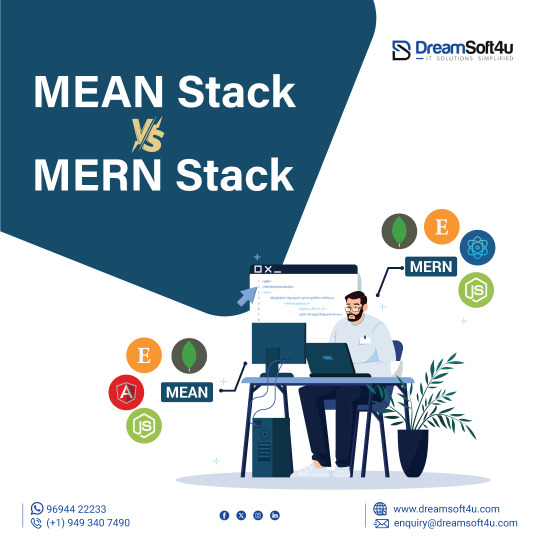
Both MEAN and MERN tech stacks are versatile and easy to use, with each technology fulfilling its role effectively. MongoDB is a popular user-friendly database, while Node and Express ensure strong server-side performance for JavaScript web apps. React and Angular handle front-end development. Overall, these stacks cover the full development cycle, are well-equipped with features, and are favored by developers worldwide.
0 notes
Text

❓ MEAN or MERN? 🤔 Which JavaScript stack is the perfect fit for your web app? 🧐 Find out in our latest blog post. 📚
0 notes
Text
What is a MEAN stack or a MEAN stack developer?
MEAN is an acronym for MongoDB, Express.js, Angular.js, and Node.js. And one can define MEAN Stack as a modern approach to web development as MEAN stack is an amalgamation of JavaScript-based web development technologies. These technologies help MEAN Stack developers create robust apps and websites without hassles. In a nutshell, MEAN Stack is a free, open-source JavaScript framework with an extensive suite of built-in testing tools. Let us now read about MEAN Stack in detail.
MongoDB
1. It is a NoSQL document-based backend database.
2. It uses collections and documents to store high volumes of data.
3. It extends Cloud functionalities and saves the data in binary JSON format.
Express.js
1. It is a backend web application framework for application programming interfaces.
2. It helps create single, multi, or hybrid page apps.
3. It is a node-based server layer providing logic for the MEAN stack.
Angular.js
1. It is an open-source front-end JavaScript framework intended to be used for the user interface.
2. It assists MVC design that efficiently structures business and web applications.
3. It employs the HTML syntax to express various syntax.
Know more -
0 notes